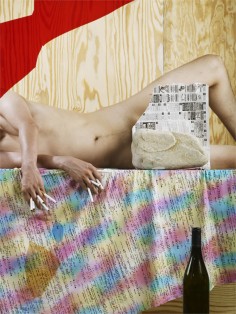Michele Abeles
Red, Rock, Cigarettes, Newspaper, Body, Wood, Lycra, Bottle
source: momaorg
Michele Abeles’s studio constructions combine common objects—wine bottles, terra-cotta pots, newspapers, and printed fabrics—with nude males. Abeles’s props are familiar and generic, even bland, with minimal symbolic or narrative associations. Her models, cast via Craigslist ads, are also positioned like props, often posed so their bodies are truncated by the frame. Titles such as Red, Rock, Cigarettes, Newspaper, Body, Wood, Lycra, Bottle, which inventory the objects in the photograph, further emphasize the pictures’ generic quality.
In Abeles’s photographs, space appears flattened, and scale and spatial relationships are often confusing. A lot of the trickery occurs in the camera or in the studio—for some pictures, the artist placed colored gels over Plexiglas in front of her lens to produce geometric and fragmented layers that mimic digital post-production manipulations. In 2012, responding to the way images are consumed in the media-saturated 21st century, Abeles began making photographs employing digital tools. These works refer to how we view images today: often on a computer screen, a flattened space cluttered with layered windows. #4 recalls the swipe mechanism on an iPad or iPhone, a cropped image on the left suggesting a picture in mid-swipe. In response to the endless recirculation of images in mass culture today, Abeles has used elements of her older photographs to make new work, as in Progressive Substitution Drills, in which a rock, printed fabric, and newspaper scrap from earlier photographs appear. In her work, Abeles layers and builds space, drawing attention to the space between things and, ultimately, the space between pictures.
Michele Abeles was born in 1977 in New York. She received a BA from Washington University in St. Louis in 1999 and an MFA from Yale University in 2007. Abeles lives and works in New York City.
.
.
.
.
.
.
.
source: blogvoccomcn
米歇尔·埃伯利斯(Michele Abeles)是当代艺术界颇有影响的艺术家,她的作品以摄影为媒介,被赋予了更多装置主义的含义。埃伯利斯将花布、盆栽、酒瓶等寻常物按照自己的构思重新组合在一起,为他们拍下“肖像”,从而形成新的艺术作品。这种源自波普艺术的做法在当代艺术领域虽然并不少见,但通过摄影来呈现的方式也让其成为 “新摄影”展的亮点。
埃伯利斯曾经提出过这样一个问题:“除了街头摄影,还有什么摄影是没有人为安排的?”这是一个意味深长的问题,尤其是来自一个耶鲁大学MFA摄影课程毕业生的提问,更是绝非偶然。埃伯利斯毕业后曾是耶鲁大学女校凯蒂·格拉南的助手,不久后,她就开始了自己的研究生涯。她曾经拍摄人物,但是越来越对肖像之外的照片制作发生兴趣,甚至求助于心理学的空间。她将人体看成是一种中立的物体,在她的照片中人体和其他的物体没有太大的区别,类似于酒瓶,红陶花盆,报纸,印刷织物等等。这些人工的制品有一种相似性,就是时间上的永恒性,甚至是毫不显眼、平淡无味。
当然她所选择的所谓的“中立的”人体还是有一定标准的,白种人,不能太廋也不能太胖,不能有太多的毛发或者过于污浊,否则不为所取。拍摄的环境设置得很优雅,身体显得平面化,图案化,压缩在框架中。作品的标题也很有特点:红色,岩石,雪茄,报纸,身体,木料,织物或者瓶子,就像是一系列货物的清单,随心所欲,更看重的是画面物体的积累和交叠。这样的构成如同一个世界,一种表现主义的而非现实的空间。
这些年来,摄影所面对的一个不可避免的问题,就是涉及到对数码技术强化后的质疑。在埃伯利斯的照片中,空间所呈现的效果是平面的:和空间纬度相关的参数都被混淆了。这一切其实都发生在当代摄影的实验室中,发生在照相机里。从某种意义上说,埃伯利斯通过大量的时间寻找有意味的空间。包括在镜头前面放置一些可以强化的元素,远比使用PS来得更为直接而有效。
2012年,她使用的照相机已经内置了数码合成功能,所以她现在全方位地充分利用这些有效的手段,不管是数码的还是其他的手法。她最近的作品也许想告诉我们今天观看事物的方式:经常是在计算机的屏幕前,是一个二维的平面空间,混淆了现实的空间。对于埃伯利斯或者我们大多数人来说,屏幕就是我们所栖息的另一个世界,她通过常见的数码技术,唤起我们对这样一个空间的认知感。


